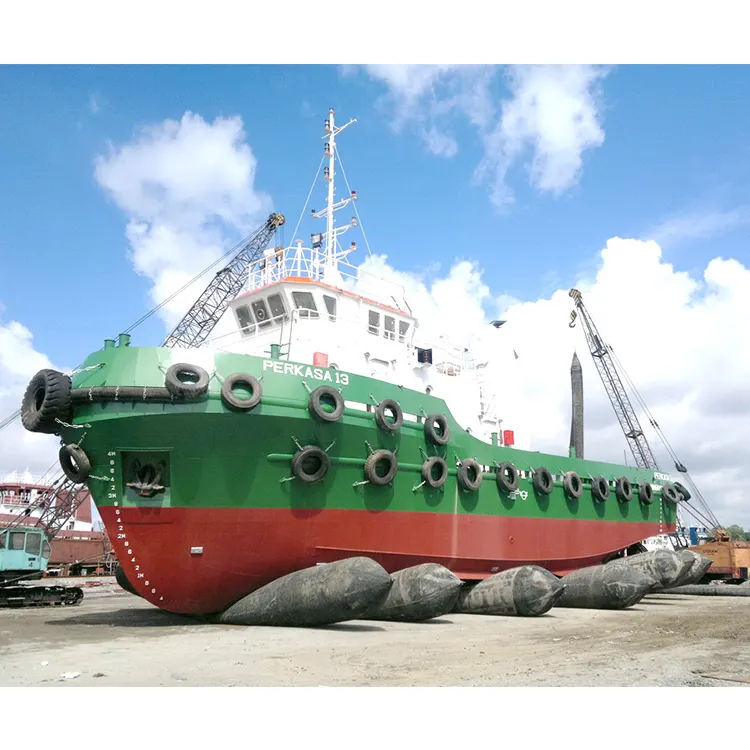Როგორ მუშაობს გამზირი საშენო აირბეგები: ძირითადი მექანიკა
Ბუიანის მექანიკა კრიზის სიტუაციაში
Გადარჩენის საჰაერო ბალონები მძიმე საგნების, როგორიცაა ჩაძირული ნავების ასაყვანად ეყრდნობა ამპლუატობას. ამ ბალონების შეფუთვა წყლის გადაადგილებას იწვევს და შესაბამისად, ზემოთ მიმართულ ძალას იწვევს ჩაძირული საგნების ასაღებად, რაც არქიმედეს პრინციპის გამოყენების კლასიკური მაგალითია. ავარიულ სიტუაციაში ამპლუატობის სტრუქტურას სწრაფად და ეფექტურად უნდა მოაწვდეს და უზრუნველყოს მხარდაჭერა იმისათვის, რომ ნავი უსაფრთხო და აწეულ პოზიციაში მოყვანილ იქნას. ბალონების ფორმისა და მასალის თვისებების აეროდინამიური ოპტიმიზაცია შესაძლოა გაუმჯობესოს ბალონების მომსახურება რთულ პირობებში ან ძლიერ დენებში, გარემოს არასტანდარტული მდგომარეობიდან გამომდინარე. კარგად განხორციელებული ამპლუატობის მექანიკა მთავარი პირობა იყო 300 ტონიანი პარომის ასაყვანად ინდონეზიაში.
Სწრაფი გამოყენების პროტოკოლები
Წარმატებით განახლებული დაზღვევა დამოკიდებულია სწრაფად ჩართულ ჰელიუმის კუშის გამოყენებაზე და დროს მართვაზე, რაც ყველაფერია, როდესაც ველექსის მაღალი დაზღვევის შეზღუდვა სჭირდება. ჩართვის პროცედურები უნდა იყოს გამოყენების მარტივი და გამოსახატებელი განსხვავებულ მარიტიმურ სიტუაციებში და უნდა იყოს გამოსახატებელი მარტივად განსხვავებულ მარიტიმურ პირობებში. განათლება და სიმულაცია ძველი არის ჩართვის დროს მინიმიზაციისთვის, და რამდენიმე სტატისტიკა ჩვენს, რომ კარგად განათლებული გუნდი შეიძლება ჩართოს ჰელიუმის კუში ხუთ წუთში. ის ასე სწრაფად ჩართებადია გამომწვევი სტრატეგიული ჰელიუმის კუშის დასაწყებისა და სოფისტიკირებული ავტომატიზაციის ტექნოლოგიის. ეს მაგალითია 40%-იანი შემოწმების დროის შეკუმშვისა, რომელიც გამოიყენება ავტომატური შესაფარების ტექნოლოგიით იტალიის სანაპირო მოქმედებებში.
Სიღრმის ტოლერანსი და წნევის წარმომადგენლობა
Რეკვირების აირბეგები მაღალ ჰიდროსტატურ წნევის ქვეშ არის, განსაკუთრებით ძილად წყლის ადგილებში, სადაც ვერახალი გამოჩენის პროცენტი ზრდება. მასალების მეცნიერებაში განვითარებაც სა Gaussian არის პროდუქტების ცხოვრების გაფართოებაში, რათა მათ გამოყენება ექსტრემალურ გარემოში. სიღრმის მახარების შესახებ ცოდნა მწარმოებლებს გაძლევს შესაბამის აირბეგის გამოყენებას გარკვეულ სიტუაციაში. სტანდარტული ტესტირება გარკვეულ სიღრმეებზე რეკომენდება, რადგან მიcirca 30%-ი ვერახალი გამოჩენები დაკავშირებულია წნევის წინააღმდეგობასთან. ეს ტესტების წარმატება დასადებს, რომ მძიმე სინთეტური მასალები მაღალი მართვა ასახავს ძილად წყლის მუშაობაში, მარინის რეკვირების მოქმედებაში მისაღები დახმარების მისაღები.
Ძილად წყლის აირბეგების ძირითადი მონაწილეობები
Ღრუბლის დიზაინი ღრუბლის გარემოში მუშაობისთვის
Სამინდივე აირბეგები შექმნილია უკანონიერი წინადადებითი წნევის მოთხობით, რომლებიც საჭიროა გრძელი ღრუბელებში მუშაობისთვის. ეს აირბეგები შეძლებენ წინადადებითი წნევის გამარტივებას გრძელი ღრუბელებში, და საჭირო მასალები განსაზღვრულია, რომელიც უზრუნველყოფს სტრუქტურის მთავრობას და უსაფალო მუშაობას. მასალების სწორი არჩევანი ძვირად არის საჭირო, რომ აირბეგები წარმატებით მუშაობდნენ სასარგებლო პირობებში, არ დაკარგებული უსაფალობის გამო. ვირობის/ფლიტის მუშაობა განათავსებულია, რომ ღრუბელის გამოსაშლელო ცდები უფრო წარმატებულია, თუ აირბეგები მiliki წინადადებითი წნევის მოთხობა.
Სინთეტიკური ტირის-კორდის სარეზერვო მდგომარეობა
Ინგებრით შექმნილი ტირის კორდის ფუძე არის გამოჩენა, რომელიც გაზრდის ამ გადაშვებული ჰელიუმის ღირების გარეშე ხელმისაწვდომობას, მაღალი დაცვით პროტექციით წყაროებისა და გამოტანის წინააღმდეგ. ეს მოდერნული კონსტრუქციის მეთოდი არამატებად აღდგენს ღირების პროფილს და ხელს უწყობს მისი წონას, რაც ორი ძირითადი მახასიათებელია ქვე-წყლების აღდგენისთვის. სტატისტიკური მონაცემები ჩვენს, რომ ღირებები სინთეტიული ტირის კორდით 40%-ით ნაკლებად არიან ვერ წარჩენილები ვიდრე არა-დაცვილი ღირებები.
6:1 ბезопасностный фактор с интегрированными функциями
6:1 მარტივობის ფაქტორი, შენახული ჰელიუმის კუთხეებში, ნიშნავს, რომ ისინი შეფასდება ჩატარებადი ბრუნავები მაქსიმუმ ექვსჯერ მაღალი მისი შეფასებული მოცულობაზე, რაც არის ძველი მახასიათებელი მოთხოვნათა შენახვისთვის. ავტომატური წნევის გასართობის და ინტეგრირებული მაღალი დაჭერის წერტილების მსგავსად, ეს ჰელიუმის კუთხეები გაძლევენ გაზრდილ კონტროლს უფრო სწრაფი გამოყენებისთვის. გამოკვლებები ამბობენ, რომ პროფესიონალები, რომლებიც გამოყენებენ ეს ფაქტორებს, შეძლებენ უფრო მั่ნამრე მუშაობას, რაც განაპირობა გამოქვეყნების უფრო მაღალი მარტივობა.
Ტიპები შენახვის ჰელიუმის კუთხეებისა და კონფიგურაციები
Закрытые цилиндрические подъемные мешки
Დახურული ცილინდრული წყალში აღჭერის კუთხი დახურული ცილინდრული აღჭერის კუთხები მრავალფეროვანი იнструმენტებია, რომლებიც შეიძლება იყენებოდნენ განსხვავებული მიცხრევი და აბჯექტის დაბრუნების დავალებებისთვის, განსაზღვრული ბუენობის გამოსახატვად ქვე-წყალში საშინელო სამუშაოში. ეს კუთხეები შეიძლება იყენებოდნენ тяжелой დამალვისა და აღჭერის სიტუაციებში, როგორიცაა დიდი ჩამორჩენილი სამეზობები და სტრუქტურები. მათი ელიპტური ფორმა შეიძლება განსაზღვროს მაქსიმალური აღჭერის სიმძლავრე, რაც ძალიან შესაბამისია განსხვავებულ მდგომარეობებში განსხვავებული წყლის სიღრმეებით. ეს კუთხეების ეფექტივობა დამალვისა და საშინელო სამუშაოში ხშირად განაცხადებულია ინდუსტრიის ექსპერტების მიერ. როგორც მაგალითი, არსებობს ბევრი შემთხვევითი ისტორიები, რომლებიც ნაჩვენებია მათი დამტკიცებული ფუნქციონირება ყველაზე სამართლიან პირობებში, რაც დადასტურებს მათი განსა Gaussian როლი მარინის აპარატურის გამოყენებაში.
椽ჯერებით განახლების სისტემები
Რეზინით დამაგრებული გადარჩენის სისტემები უზრუნველყოფს მოქნილობისა და გამძლეობის შესანიშნავ კომბინაციას, რაც აუცილებელია პროგნოზული და არასტაბილური საზღვაო პირობების შესახებ. ეს კონსტრუქციები შექმნილია რეზინით დამაგრებული რამდენიმე ფენისგან, რათა უზრუნველყოს შიდა ხრახნის მყარი მხარდაჭერა მსუბუქობის შენარჩუნებით. კვლევები აჩვენებს რეზინით დამაგრებული საჰაერო ბერკეტების უზარმაზარ სარგებელს დაუშვების დროის შესამცირებლად. ეს მონაცემები დაკავშირებულია ეფექტუალური აღდგენის მისიების 25%-ით გაზრდასთან. ამგვარად, სისტემები ასახავს რეზინის მყარ მოთხოვნას მოქნილობისა და გამძლეობის მიმართულებით გადარჩენის საქმეში.
Პარაშუტის ტიპის ქვემოთ მოგვარავებული ამოხსნები
Პარაშუტის სისტემები წარმოქმნილია განყოფილი სისტემის დიზაინი, რომელიც შეიძლება წარმოადგინოს წყლის ქვემოთ გადახრისა და მუდმივობის შექმნას და ძალიან მნიშვნელოვანია კონტროლირებული აღდგენისთვის ჩამორთული ადგილებისთვის. ასეთი სისტემები ყველაზე მეტი მნიშვნელოვანია, მაგალითად, ნაგადავი ველების ან არა მუდმივი პირობების მართვაში, რომლებიც შეიძლება წარმოადგინონ მნიშვნელოვან რისკებს აღდგენის მისაღებაში. პროფესიონალური შეფასებები უყვარს იმით, რომ პარაშუტის სტილის ან კანოპის ტიპის ჰავერსაკები მოგვაქვს 30%-ზე მეტი აღდგენის ალბათობას რაღაც რთულ ტერიტორიაში. ასეთი პარაშუტის სისტემები ამავე მიზნით მუდმივი ამაღლების გარანტია წყლის ქვემოთ, სადაც მუდმივობა და წარმატება ყველა რთული პირობის მიმართ გარანტირებულია.
Გამოყენება წყლის ქვემოთ შენახვის მისიებში
Ღირებულების აღდგენა ღრუბლის მწყენებში
Სალვაჟის აერუკანობის ერთ-ერთი ყველაზე მნიშვნელოვანი დავალება მარინა საჭიროების გადაწყვეტისას არის ჩამოსული სატანაროების ხელახლა გაფლობა. ეს სისტემები საშუალებას ძ gaussian ს ჩამოსული ქცევების სწრაფი სალვაჟი აერუკანობების მასივის გამოყენებით, რომლებიც ხელს უწყობენ აღწერისა და შემდეგი დარტყმის ან ჩამოსვლის პრევენციაში. მარინა სალვაჟის აერუკანობები გთავაზობენ მარტივად ჩამოთვლადი ამოხსნას, რომელიც ჩანათვალით გამოდგენილია კოსტ-ეფექტურად და უფრო უსაფრთხოდ, სწრაფი 70%-ზე მეტი წარმატების გამოსახურებით ღრმი წყლებში, როგორც აჩვენებს რამდენიმე გამოკვლევა. ზუსტად ეს მახასიათებლები აძლევენ იმ ორი მახასიათებელს, რომელიც საჭიროა ეფექტური სატანარო აღწერისთვის – სტაბილობა და გაფლობა, რაც შეამცირებს მათ გარემოულ ნიშნებს تقليს ალტერნატივებზე, რაც ხდის აერუკანობებს უნდა გაქვთ მარიტიმული აღდგენისთვის.
Სამყაროების კონფიგურაცია სამყარო წყაროში
Საზღვაო წყლებში, მარინული გადაცემის აირბეგები pionoon არის „აირბეგი“ ფორმის ყველაზე გამართლებული ვარიანტი გადასაჭრისა და აღჭრისთვის. პიუნტები წარმოადგენენ მั Gaussian პლატფორმას, რომელიც შანსის მცირედ აკლავს ნავთის და გარეგნის დაზღვევას და ამაღლებს აღჭრის შესაძლებლობას. კვლევა ჩვენს, რომ პიუნტების დაჯგუფება შეიძლება აჩქაროს სამუშაო გრაფიკი მაქსიმალურად 20%-ით, რაც მიუთითებს მათ პოტენციალს მოქმედების გრაფიკის შეკლებაზე. სწრაფი დამატება, არ არის საჭირო მხარდაჭერის ნავთები, მაქსიმალურად 50% ხარჯების შენახვა, ძლიერი და გამძლეების მარტივი და მორგების შესაძლებლობა, რომელიც შესაძლებელია საზღვაო წყლებში, სიგრძე საჭიროდ შესაბამისად. იგი დამტკიცებს თანმიმდევრობასა და მორგების მარტივობას საზღვაო გადაწყვეტილებებში.
Მარინული გადაცემის აირბეგების მართლიანი მწარმოებლების არჩევა
Სერტიფიკაცია და კომპლიანსის სტანდარტები
Ეს არის მთლიანად გარკვეული და ბაზის შემოწმების მიმართული საქმე, როცა აირბეგის მარინული შენახვის მომწიფეს აირჩევენ საბაზისო კომპლიანსის და სტრიქტული მიმართულების სერტიფიკატებზე. ეს სერტიფიკატები არის გარანტია, რომ აირბეგი შესაბამისია რაოდენობის მოთხოვნების მიმართულებისთვის საუსამართლო და მუშაობის მარინულ გარემოში მაღალი წნევის განმავლობაში. სერტიფიკაცია ძირითადი სახელმწიფოების მიერ, როგორიცაა IMO, წარმოადგენს გრძნობის სტანდარტს ხარისხის გარანტირებაში, რომელიც გარანტირებს გამოყენების სიმსუბუქობას და ეფექტოვანობას რეალურ გამოყენების სიტუაციაში. კვლევა ჩვენს, რომ მომწიფეები, რომლებიც მiliki ეს სერტიფიკატები, 50%-ით მეტად არიან შანსი კლიენტის სატისფაქციოდებაში, რაც ძალიან გარკვეულია მაღალი სტაკანის შენახვის სიტუაციაში.
Მასიური ეკონომიკური გამოთვლები
Მასიური ეკონომიასთან ერთად არის ძალიან გამოსავალი პროფიტი, რაც არის მიზეზი იმისა, რათა ყურადღებით აირჩიო წარმოშლილი ჰავის მწარმოებელი. ეს არ მხოლოდ განსაზღვრული ფინანსური შენახვა არის, არამედ მიიღება სწრაფად გარემო ინსტრუმენტები მარიტიმული აქციდენტების შემთხვევაში. რათა მაქსიმალურად გამოიყენოთ ეს პროფიტები, აუცილებელია განახლებული პირობების შესახებ ინფორმაცია. 20 Aug 2019| Knowledge Market research shows that when companies purchase in bulk, they experience a 30% decline in 30% operational issues, as a result of better support from the supply sources.
Ლოკალური წინააღმდეგი გლობალურ მომწიფეთან შემთხვევის ქსელები
Ლოკალური და გლობალური მწადელთა ქსელის შედარება შეიძლება მნიშვნელოვან გავლენას ახდენდეს ზღვის დაცემის ჰაერის ჩატარების ეფექტივობაზე. ლოკალური მწადელთა წყაროები ასევე შეიძლება გადაწყვეტილი პასუხი მიეცათ უფრო სწრაფად, ასევე პირდაპირი, განსაკუთრებული სერვისი, რაც ძირითადია განაპირობებული მუშაობისთვის. მეორე მხარეს, საერთაშორისო მწადელები ზოგადად მეტ ნარჩენი პროდუქტების არჩევანი ჰქონდენ. უახლესი კვლევა ნაჩვენებს, რომ ლოკალური მწადელები ჩვეულებრივ უფრო სწრაფი არიან განაპირობებულ სიტუაციებში, რაც მიყვანს ყურადღეს ლოკალური ლოგისტიკის ცოდნის მნიშვნელობაზე მწადელთა ქსელის შემუშავებისას. ეს ბალანსი ასევე შესაძლებლობას აძლევს სწრაფი წარმოების და განსხვავებული პროდუქტების ხაზებისთვის.


